Role Disaster Name Hartford fire | Non-fatal injuries 700+ Deaths 167-169 Date July 6, 1944 | |
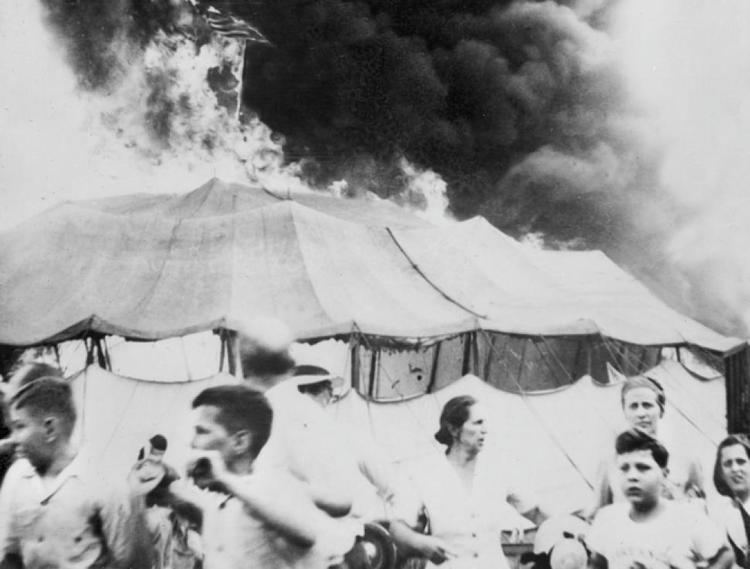 | ||
Similar Beverly Hills Supper C, Cocoanut Grove, Hammond Circus Train Wre, Our Lady of the Angels School fire, The Station nightclub fire | ||
1944 hartford circus fire the big top collapse
The Hartford circus fire, which occurred on July 6, 1944, in Hartford, Connecticut, was one of the worst fire disasters in the history of the United States. The fire occurred during an afternoon performance of the Ringling Bros. and Barnum & Bailey Circus that was attended by 6,000 to 8,000 people. 167 people died and more than 700 were injured.
Contents
- 1944 hartford circus fire the big top collapse
- The life of reilly 13 hartford circus fire
- Background
- The fire
- First investigation
- Segees confession
- Little Miss 1565
- Proposed identifications
- Ongoing questions
- Personal accounts
- Hartford and the circus today
- Non fiction and fiction
- Notable survivors
- References
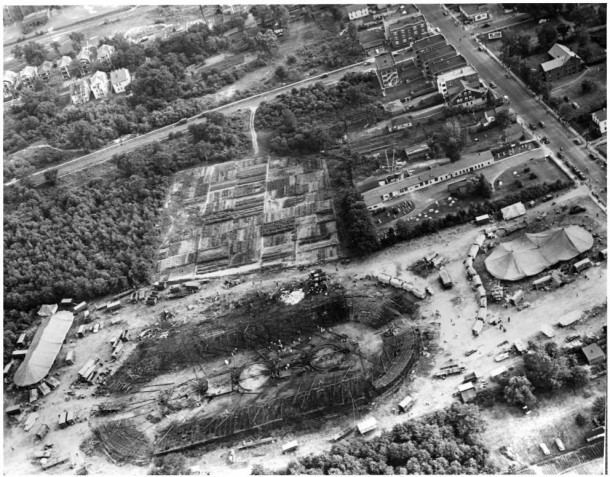
The life of reilly 13 hartford circus fire
Background

In mid-20th century America, a typical circus traveled from town to town by train, performing under a huge canvas tent commonly called a "big top". The Ringling Brothers and Barnum & Bailey Circus was no exception: what made it stand out was that it was the largest circus in the country. Its big top could seat 9,000 spectators around its three rings; the tent's canvas had been coated with 1,800 pounds (820 kg) of paraffin wax dissolved in 6,000 US gallons (23,000 l) of gasoline, a common waterproofing method of the time.
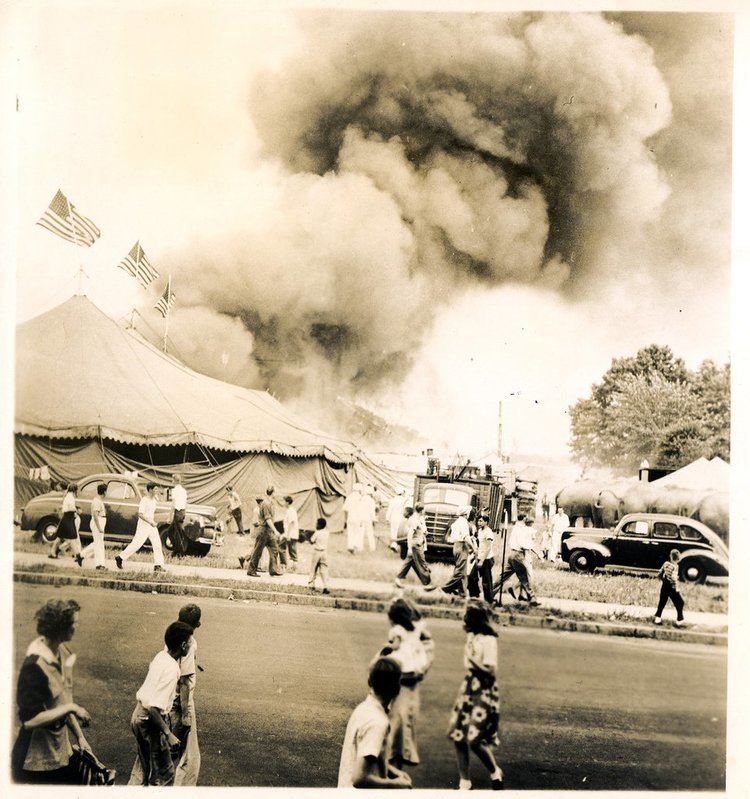
The circus had been experiencing shortages of personnel and equipment as a result of the United States' involvement in World War II. Delays and malfunctions in the ordinarily smooth order of the circus had become commonplace; on August 4, 1942, a fire had broken out in the menagerie, killing a number of animals. When the circus arrived in Hartford, Connecticut, on July 5, 1944, the trains were so late that one of the two shows scheduled for that day had been canceled. In circus superstition, missing a show is considered extremely bad luck, and although the July 5 evening show ran as planned, many circus employees may have been on their guard, half-expecting an emergency or catastrophe.
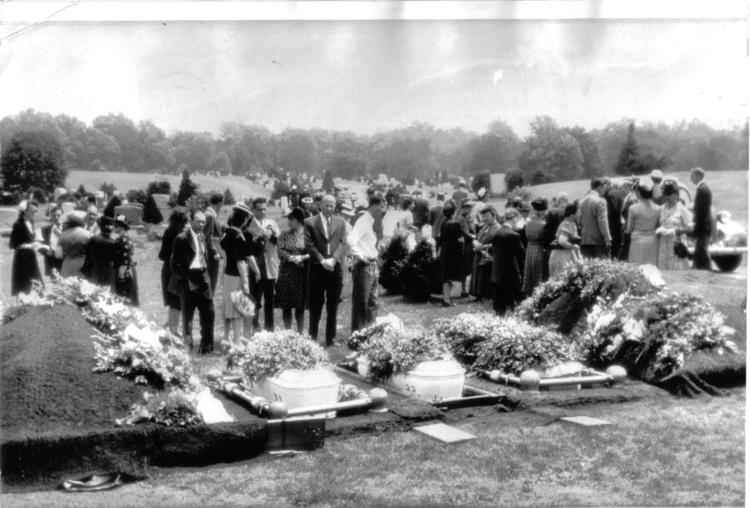
The next day was a Thursday; the crowd at the afternoon performance was dominated by women and children. The size of the audience that day has never been established with certainty, but the best estimate is about 7,000.
The fire
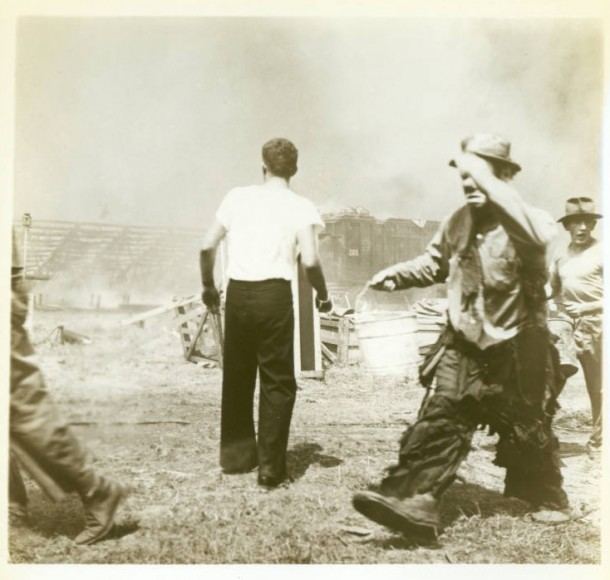
The fire began as a small flame after the lions performed, on the southwest sidewall of the tent, while the Great Wallendas were performing. Circus bandleader Merle Evans was said to have been the first to spot the flames, and immediately directed the band to play "The Stars and Stripes Forever", the tune that traditionally signaled distress to all circus personnel. Ringmaster Fred Bradna urged the audience not to panic and to leave in an orderly fashion, but the power failed and he could not be heard. Bradna and the ushers unsuccessfully tried to maintain some order as the panicked crowd tried to flee the big top.
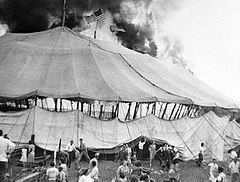
Sources and investigators differ on how many people were killed and injured. Various people and organizations say it was 167, 168, or 169 persons (the 168 figure is usually based on official tallies that included a collection of body parts that were listed as a "victim") with official treated injury estimates running over 700 people. The number of actual injuries is believed to be higher than those figures, since many people were seen that day heading home in shock without seeking treatment in the city. The only animals in the big top at the time were the big cats trained by May Kovar and Joseph Walsh that had just finished performing when the fire started. The big cats were herded through the chutes leading from the performing cages to several cage wagons, and were unharmed except for a few minor burns.
The cause of the fire remains unresolved. Investigators at the time believed it was caused by a carelessly flicked cigarette; however, others suspected an arsonist. Several years later, while being investigated on other arson charges, Robert Dale Segee (1929–1997), who was an adolescent at the time, confessed to starting the blaze. He was never tried for the crime and later recanted his confession.
Because of the paraffin wax waterproofing of the tent, the flames spread rapidly. Many people were badly burned by the melting paraffin, which rained down from the roof. The fiery tent collapsed in about eight minutes according to eyewitness survivors, trapping hundreds of spectators beneath it.
It is commonly believed that the number of fatalities is higher than the estimates given, due to poorly kept residency records in rural towns, and the fact that some smaller remains were never identified or claimed. It is also believed that the intense heat from the fire combined with the accelerants, the paraffin and gasoline, could have incinerated people completely, as in cremation, leaving no substantial physical evidence behind. Additionally, free tickets had been handed out that day to many people in and around the city, some of whom appeared to eyewitnesses and circus employees to be drifters who would never have been reported missing.
While many people burned to death, many others died as a result of the ensuing chaos. Though most spectators were able to escape the fire, many people were caught up in the hysteria. Witnesses said some simply ran around in circles trying to find their loved ones, rather than trying to escape from the burning tent. Some escaped but ran back inside to look for family members. Others stayed in their seats until it was too late, assuming that the fire would be put out promptly.
Because at least two of the exits were blocked by the chutes used to bring the show's big cats in and out of the tent, people trying to escape could not bypass them. Some died from injuries sustained after leaping from the tops of the bleachers in hopes they could escape under the sides of the tent, though that method of escape ended up killing more than it saved. Others died after being trampled by other spectators, with some asphyxiating underneath the piles of people who fell over each other.
Most of the dead were found in piles, some three bodies deep, at the most congested exits. A small number of people were found alive at the bottoms of these piles, protected by the bodies on top of them when the burning big top ultimately fell down. Because of a picture that appeared in several newspapers of sad tramp clown Emmett Kelly holding a water bucket, the event became known as "the day the clowns cried."
First investigation
On July 7, charges of involuntary manslaughter were filed against five officials and employees of Ringling Bros. Within days of these charges being filed, the circus reached an agreement with Hartford officials to accept full financial responsibility and pay whatever amount the city requested in damages. This resulted in the circus paying out almost US$5,000,000 to the 600 victims and families who had filed claims against them by 1954. All circus profits from the time of the fire until then had been set aside to pay off these claims.
Although the circus accepted full responsibility for the financial damages, they did not accept responsibility for the disaster itself. The five men charged were brought to trial in late 1944; four were convicted. Although they were given prison terms, the four men found guilty were allowed to continue with the circus to their next stop, in Sarasota, Florida, to help the company set itself up again after the disaster. Shortly after their convictions, they were pardoned entirely. One of the men, James A. Haley, went on to serve in the U.S. House of Representatives for twenty-four years.
Segee's confession
In 1950, Robert Dale Segee of Circleville, Ohio claimed he was responsible for setting the circus fire. Segee, a roustabout for the show from June 30 to July 14, 1944, when he was about 14 years old, said he had a nightmare in which an Indian riding on a "flaming horse" told him to set fires. He further claimed that after this nightmare his mind went blank, and that he did not come out of this state until the circus fire had already been set. It was said Segee fit the description of a serial arsonist right out of a psychiatrist's textbook. Segee also knew intimate details of the incident, which some believed only the real arsonist could have known. For instance, it was never made public that the circus had two smaller fires of undetermined origin prior to the tragedy. Segee admitted setting both of them as well. These statements, Segee added, were in response to a later dream he'd had of a woman standing in flames urging him to confess.
In November 1950, Segee was convicted in Ohio of unrelated arson charges and sentenced to 44 years of prison time. However, Hartford investigators raised doubts over his confession, as he had a history of mental illness, and it could not be proven he was anywhere within the state of Connecticut when the fire occurred. Connecticut officials were also not allowed to question Segee, even though his alleged crime had occurred in their state. Additionally, Segee, who died in 1997, denied setting the fire as late as 1994 during an interview. Because of this, many investigators, historians and victims believe the true arsonist—if it had indeed been arson—was never found.
Little Miss 1565
The best-known victim of the circus fire was a young blonde girl wearing a white dress. She is known only as "Little Miss 1565", named after the number assigned to her body at the city's makeshift morgue. Oddly well preserved even after her death, her face has become arguably the most familiar image of the fire.
Her true identity has been a topic of debate and frustration in the Hartford area since the fire occurred. She was buried without a name in Hartford's Northwood cemetery, where a victims' memorial also stands. Two police investigators, Sgts. Thomas Barber and Edward Lowe, photographed her and took fingerprints, footprints, and dental charts. Despite massive publicity and repeated displays of the famous photograph in nationwide magazines, she was never claimed. Barber and Lowe spent the rest of their lives trying to identify her. They decorated her grave with flowers each Christmas, Memorial Day, and July 6. After their deaths, a local flower company continued to decorate the grave. In 1991, the body was declared to be that of Eleanor Emily Cook, despite the fact that her aunt and uncle had examined the body and it did not fit the description they provided. The Connecticut State Police forensics unit compared hair samples and determined they were probably from the same person. The body was exhumed in 1991 and buried next to her brother, Edward, who had also died in the fire.
Proposed identifications
In 1981, Lowe's widow announced that Lowe had identified the child and contacted her family, but they had requested no publicity. In 1987, someone left a note on the 1565 gravestone reading Sarah Graham is her Name! 7-6-38 DOB, 6 years, Twin. Notes on nearby gravestones indicated that her twin brother and other relatives were buried close by.
In 1991, arson investigator Rick Davey (along with co-writer Don Massey) published A Matter of Degree: The Hartford Circus Fire and Mystery of Little Miss 1565, in which he claims the girl was Eleanor Emily Cook and from Massachusetts. Davey also contends that there was a conspiracy within the judicial system to convict the Ringling defendants, and that Segee was the arsonist. Prior to writing the book, Davey spent six years researching the case and conducting his own experiments as to how the fire really may have started. He described the original investigation both "flawed and primitive", though he did not work on the original case. Eleanor's brother Donald Cook had contacted authorities in 1955 insisting that the girl was his sister, but nothing came of it, and Donald later worked with Davey to establish her identity. Donald believes that family members were shown the wrong body in the confusion at the morgue.
Ongoing questions
Various assertions put forth in A Matter of Degree have been fiercely disputed by investigators who worked on the case, as well as by other writers, most notably Stewart O'Nan, who published The Circus Fire: A True Story of an American Tragedy in 2001. O'Nan points to the fact that Little Miss 1565 had blonde hair, while Eleanor Cook was a brunette. The shape of Little Miss 1565's face and that of Eleanor Cook are dissimilar, and the heights and ages of the two girls do not match up.
Perhaps most significantly, when shown a photograph of Little Miss 1565, Eleanor's mother Mildred Corintha Parsons Cook immediately stated that this was not her daughter. She firmly maintained that stance until her death in 1997, age 91. Badly injured in the fire, Mrs. Cook had been unable to claim her two dead children, and was too emotionally traumatized to pursue it later. She'd been told that Eleanor was not in any of the locations where bodies were kept for identification. She believed that Eleanor was one of two children who had been burnt beyond recognition and remain unidentified. O'Nan thinks she may be body number 1503. He further points to the differences in the dental records of Eleanor Cook and the records made of Little Miss 1565 after her death.
As O'Nan and others have pointed out, the most likely scenario is that a family claiming a body early on mistakenly identified Eleanor Cook as their own child and she is buried under that child's name. Even when "Little Miss 1565's" picture ran in the papers, they failed to recognize her as their own due to their desire to put the traumatic event behind them. While DNA analysis could end this debate definitively, the logistics of exhuming all the likely candidates for this mix-up make this unlikely.
With the questions over whether Eleanor Cook is the true identity of Little Miss 1565 still unanswered in the eyes of many, the body was exhumed after the release of A Matter of Degree and buried in Southampton, Massachusetts, next to the body of Edward Cook, the brother of Eleanor Cook and a victim of the circus fire himself. In 1992, her death certificate was officially changed from the previous identification of "1565". Since then, the Cook family has raised questions about whether the body is indeed that of Eleanor Cook, and some investigators have come to believe Eleanor's body may have been another of the unclaimed bodies from the fire and not Little Miss 1565.
Personal accounts
One of the survivors of the fire, Maureen Krekian, discussed her ordeal in 2007. She was 11 at the time of the fire, and lived on the same road where the circus was held. On the day of the event, she was supposed to go to the circus with a woman next door and her daughter. When she went to their house, she found that they had already left without her. She decided to go to the circus on her own, where she seated herself in the bleachers.
I remember somebody yelling and seeing a big ball of fire near the top of the tent. And this ball of fire just got bigger and bigger and bigger. By that time, everybody was panicking. The exit was blocked with the cages that the animals were brought in and out with. And there was a man taking kids and flinging them up and over that cage to get them out. I was sitting up in the bleachers and jumped down — I was three-quarters of the way up. You jump down and it was all straw underneath. There was a young man, a kid, and he had a pocketknife. And he slit the tent, took my arm and pulled me out.
As she was being pulled out, Krekian grabbed another little girl's arm and pulled her out as well.
Actor and theater director Charles Nelson Reilly, who was thirteen years old at the time, survived the fire and dramatized it in the film of his stage show, The Life of Reilly. In a 1997 interview, Reilly said that he rarely attended the theater, despite being a director, since the sound of a large audience in a theater reminded him of the large crowd at the circus before the disaster. He also said during his latter show that his mother, who told him not to go to the circus on that day with his friend and disobeyed her, caught them sneaking out of her sight and scolded them, saying "I hope it burns to the ground!"
Frieda Pushnik, who performed with the circus as the "Armless and Legless Wonder", was rescued by a minstrel show performer. She could not have gotten away on her own, but the minstrel performer rushed on stage, picked up her chair, and carried her to safety. Pushnik continued to perform with the circus until 1955.
Those who survived carried the trauma for decades. Seventy years after the fire, Carol Tillman Parrish, who was six at the time, said that "until this day, I can smell the stench of human flesh" as the blaze consumed its victims.
Judith Shapiro [Cohen] survived the fire. She was about 7 years old attending with her neighbors. They exited up higher into the stands and survived by jumping off; Judith refused to jump and was pushed.
Hartford and the circus today
While many of those present at the fire have avoided circuses ever since, others have returned. In May 2004, Dorothy Carvey and her son, Tighe, were given free passes for their family by Ringling Bros. to attend a show at the XL Center. For Dorothy Carvey, this was her first time attending a circus since the fire occurred. The Hartford Courant published the story of their visit, as well as what happened to them in 1944.
In 2002, the Hartford Circus Fire Memorial Foundation was established to erect a permanent memorial to the people killed in the fire. Ground was broken for the monument on July 6, 2004, at the site where the fire occurred.
Ringling Bros. and Barnum & Bailey visited Hartford during its final tour, putting on its final Hartford performance on April 30, 2017.
Non-fiction and fiction
In recent years, the Hartford circus fire has been covered in detail in several works of non-fiction and fiction. These include:
